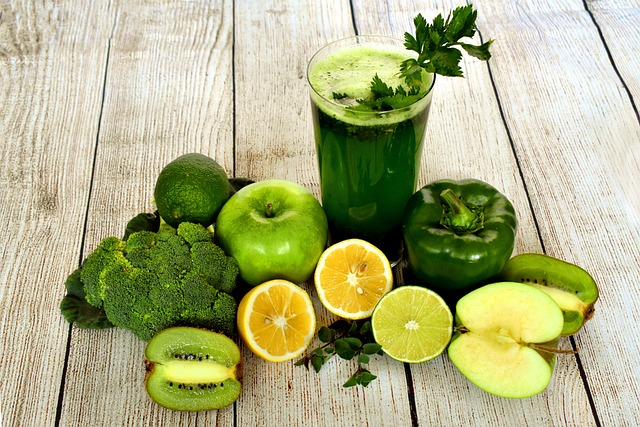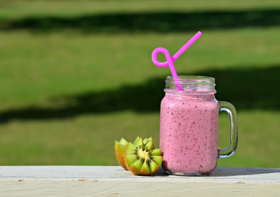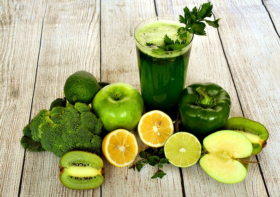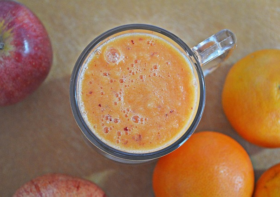15 Protein-Packed Smoothies to Fuel Your Day

- Key Takeaways
- Why Add Protein?
- Choosing Your Protein
- The Smoothie Equation
- Mastering Texture and Taste
- Strategic Smoothie Timing
- Inspired Smoothie Formulations
- Conclusion
- Frequently Asked Questions
- What are the benefits of adding protein to smoothies?
- Which protein sources work best in smoothies?
- How much protein should I add to my smoothie?
- How can I make my smoothie creamy without dairy?
- Can I use protein smoothies for weight management?
- When is the best time to drink a protein-enhanced smoothie?
- How do I prevent my smoothie from tasting chalky?
Key Takeaways
- By adding protein to these tasty concoctions, you can repair muscles, increase energy, and stay satiated. It is a vital ingredient for those with an on-the-go lifestyle.
- Mixing protein types, whether it’s dairy-based, plant-based or whole foods to meet different dietary preferences and needs creates balanced smoothies.
- All of the above is why I always advocated for the protein, carb, and healthy fat combo in my smoothie recipes.
- We’ve found texture and taste to be important. Utilize creamy ingredients like yogurt or nut butters and play around with fresh or frozen fruits to make a delicious, satisfying drink.
- When you consume your smoothie, whether it is pre or post-workouts or as a meal replacement, it can help maximize its benefits and support your goals.
- By using nutrient-dense ingredients, fiber, and superfoods, you can customize your smoothie to hit specific health goals. If you want more energy, better recovery, or simply a delicious, guilt-free indulgence, you can achieve that.
All-natural protein smoothie recipes mix in protein with fruits, vegetables, or grains to increase the nutrient content and add flavor. Many people are applying these recipes for rapid muscle recovery, sustained energy, or nutritious meal replacements.
Options include everything from dairy proteins like whey to vegan options like pea or soy. All provide a different flavor and texture. For those who are interested in simple and delicious protein boosters, these smoothies check a lot of boxes.
Why Add Protein?
Protein isn’t just about satiety. In protein-boosted smoothies, it aids post-workout recovery, provides sustained energy, controls appetite, and even increases metabolism. The synergistic effect of protein with other nutrients in smoothies aids your body in utilizing vitamins and minerals more effectively, so every sip counts.
1. Muscle Repair
Why Include Protein? After a workout, muscles receive micro-tears. Your body will use protein to repair these tears and rebuild them bigger. That’s why so many athletes grab a protein shake post-workout.
About: Why Protein? Timing is important. Consuming a protein smoothie within 30 to 60 minutes of exercise aids in faster muscle recovery. Adding more protein at just the right time can help not only repair but grow muscle as well, called hypertrophy.
Even if you’re not an athlete, this recovery can help keep your muscles healthy and strong as you get older.
2. Sustained Energy
Protein provides a slow, steady release of energy instead of a quick burst that disappears quickly. When you pair protein with your carbs in a smoothie, you get the best of both worlds: immediate energy from the carb and sustained energy from the protein.
This combination helps keep your blood sugar steady, so you don’t crash mid-morning. For those who are looking to keep up with busy days or long workouts, protein can assist with endurance and stamina.
You stay powered up longer without burnout.
3. Satiety Control
That’s why I add protein. Protein ignites signals in your body that tell your brain you’re full, so you snack less between meals. The research shows protein delays your stomach emptying and alters hunger hormones so you feel satiated longer.
Add it In: Try mixing in Greek yogurt or silken tofu for a creamy, satiating shake. A lot of weight-conscious folks opt for protein-loaded smoothies because they tend to suppress cravings, making it easier to maintain healthy routines.
4. Metabolic Boost
Why Supplement With Protein? It requires more energy for your body to digest protein than carbohydrates or fat—a process known as the thermic effect of food. In other words, you burn more calories simply by eating protein.
Maintaining your protein intake helps maintain lean muscle, which burns more calories than fat, even at rest. For the fat loss and muscle preservation crowd, protein is crucial.
5. Nutrient Absorption
Protein helps your body absorb and use vital nutrients in food. Protein, when blended with other foods in a smoothie, teams up with carbs and fats to help your gut break down and absorb vitamins and minerals better.
Certain proteins, like those from dairy or eggs, actually feed the beneficial bacteria in your gut, which can increase your digestion and overall health. If you blend protein powder into smoothies, you could find you experience improved energy and less stomach upsets because your body receives more of what it needs from every ingredient.
Choosing Your Protein

Selecting your protein is a matter of taste, nutrition and dietary needs. A protein-packed smoothie usually kicks off with a major protein player, such as Greek yogurt or some type of protein powder. With so many options, selecting the right one can make your smoothie delicious and well-rounded. Let’s take a look at the primary choices.
-
Whey protein from milk is a fast-absorbing protein and a favorite among those seeking rapid post-exercise recuperation. A lot of athletes and active types are fans of whey because it mixes well and doesn’t have a strong taste.
-
Greek yogurt contributes creaminess and delivers around 10g protein per 100g. It helps thicken smoothies and lends a tang of flavor. Select low added sugar Greek yogurt for a more nutritious mix.
-
Casein protein, which is derived from milk, digests significantly slower than whey. Its slow release can satiate you for hours and it performs beautifully in meal replacement smoothies.
-
Cottage cheese adds creaminess and a slight flavor. It has roughly 11 grams of protein per 100 grams, blends easily, and helps maintain creamy thick smoothies.
Dairy-Based
Whey protein is a staple in smoothie recipes for its quick absorption rate, perfect post-workout or at breakfast. It blends easily with most liquids and doesn’t alter the flavor significantly. Greek yogurt shines with its high protein density and luscious creaminess.
It provides texture and a bit of creaminess, just right for offsetting sweet fruits. Be wary of added sugar on labels to keep your smoothie healthy. Casein is slower digesting, so it’s a good choice if you want your smoothie to satisfy you a little longer.
Cottage cheese isn’t as typical, but it’s great for added creaminess and a hefty protein punch.
Plant-Based
Some of the most popular plant-based sources include pea protein, hemp seeds, and soy milk. Pea protein is hypoallergenic and digestible. Hemp seeds add a nutty flavor and are accompanied by omega-3 fatty acids.
Soy milk, cashew milk, and hemp milk can all contribute, particularly for vegans or lactose-intolerant individuals. Plant protein powders, such as brown rice or pumpkin seed, blend easily in a variety of recipes.
|
Protein Source |
Protein (g/100g) |
Notable Benefit |
|---|---|---|
|
Pea Protein |
20 |
Easy to digest |
|
Hemp Seeds |
31 |
Omega-3 fats |
|
Soy Milk |
3.3 |
Lactose-free option |
| Cashew Milk | 1 | Creaminess | | Plant Powders | 15-25 | Great in recipes |
Nut butters, such as almond or peanut butter, provide both protein and healthy fats. They make smoothies rich and satisfying, and they’re higher in calories. Plant protein powders are the easiest to blend and the easiest for most people to incorporate into any recipe.
Whole Foods
Whole food ingredients are a great way to bump up the protein. Chickpeas or lentils can be pureed into smoothies for a mild flavor and creamy texture. Seeds, such as chia, flax, and pumpkin, are great sources of fiber and protein, which help you stay full longer.
Oats are a gentle, fiber-packed option, and they play nicely with both sweet and savory blends. Whole fruits and vegetables, such as spinach or kale, provide small amounts of protein as well as their vitamin punch to make your smoothies a bit more balanced.
Adding these helps to get you to the recommended daily intake of approximately 53 grams of protein.
The Smoothie Equation
A smoothie is a simple mix of key parts: protein, liquid, fruit, fat, and fiber. More importantly, having these parts in the right quantities means the smoothie will not only taste good, it will help you meet your nutrition goals. You can tweak each component to accommodate your desire for a quick breakfast or a post-workout snack.
The top smoothies maintain an equilibrium: thick but not too thick, sweet but not cloying, filling but not heavy.
The Protein
Protein is essential for muscle repair and satiety. For most individuals, 15 to 25 grams per serving performs well. That is 3.5 percent protein by weight in your average 325 ml smoothie.
Whey protein blends seamlessly and contains all the amino acids you need, whereas plant-based powders such as peas or soy provide vegan alternatives. The latter can occasionally mute your drink’s hue if you go overboard. Combining two or more sources of protein will cover all amino acids and dietary preferences.
Protein pumps up the solids in any smoothie and gets you close to 23% of your daily protein requirements in just one serving. The most accurate way is to use a kitchen scale.
The Liquid
The liquid base establishes texture and flavor tone. Dairy milk lends creaminess and extra protein, while dairy-free choices such as almond or coconut milk are lighter and introduce subtle nutty or tropical undertones.
Coconut milk and almond milk are both excellent sources of healthful fats and are dairy-free. The perfect liquid ratio dictates thickness. Too much liquid thins a smoothie, while too little makes it difficult to blend.
Aim for around 200 to 250 ml per serving. Hydration from the base is key, particularly if the smoothie is your breakfast or post-gym nosh.
The Fruit
Fruits contribute sugar, color, and vitamins. Bananas, mangos, and berries pair nicely with protein powders and cover up any chalky flavor. Combining sweet and tart fruits, such as pineapple and apple, helps maintain a fresh, bright flavor.
Here’s The Smoothie Equation: frozen fruits thicken smoothies and are convenient all year, while fresh fruits maintain a clean taste but tend to thin the smoothie. Superfruits, like acai, goji, or pomegranate, add a vitamin and antioxidant boost.
Their flavors tend to be bold, so experiment with small quantities initially.
The Fat
Healthy fats smooth out the drink and help you feel full. Avocado, nut butters, and seeds are typical picks. A spoonful of almond butter, for instance, makes the texture luxuriously creamy.
Fats assist the body in absorbing vitamins A, D, E, and K from other smoothie ingredients. Balance is everything. Too much fat and your smoothie will be heavy and hide flavors.
Keep it to five to ten grams per serving.
The Fiber
Fiber keeps you satiated and your gut humming. Chia seeds, flaxseeds, oats and even some fruit contribute fiber. A 325 ml smoothie can provide roughly twenty-seven percent of your daily fiber, which is perfect for a meal on the run.
Chia and flax aid thickening the smoothie and slow the digestion of sugar, maintaining energy stability. Stir in these seeds for textural goodness.
Be sure to consume quickly once blended or you’re in for a gelled smoothie result.
Mastering Texture and Taste

Texture and taste influence the way people consume protein smoothies, regardless of their location or preferred flavors. Mastering texture and taste means understanding how to cure chalkiness, enhance creaminess, and blend flavors in a palate-pleasing way. Small tweaks such as varying your base or throwing in berries can turn a protein shake from boring into something you can’t wait to drink.
Avoiding Chalkiness
Chalkiness occurs when protein powder either doesn’t dissolve well or is of a naturally gritty variety. Certain powders, like plant-based ones, can leave a grainy mouthfeel that repels people. Milk-based or whey isolate powders typically mix smoother, though even the quality stuff requires some mixing to prevent clumps.
Blending is essential. Blending your shake in a high-speed blender for at least 30 seconds can disintegrate clumps. By dumping your liquid first—water, milk, or a non-dairy alternative such as almond milk—it aids in the powder dissolving more uniformly.
Liquid ratio is important. Too little liquid and you’ve got a gluey, sandy paste. Too much will dilute the taste. Experimenting with minor adjustments, such as incorporating an additional 50 to 100 ml of liquid, assists in discovering the optimal balance for your preferred consistency.
Allowing your shake to settle for a couple minutes lets those persistent chunks dissolve, creating an even silkier sip.
Achieving Creaminess
Creaminess is what makes a smoothie feel indulgent. Ingredients such as Greek yogurt, avocado, or oats go a long way, providing shakes with a deliciously thick and smooth foundation. They all add their own flavor. Yogurt keeps it tangy, avocado is mellow, and oats provide a light, nutty undertone.
I’ve found that frozen fruit, especially banana or mango, can add chill and body without watering down the drink. They add sweetness and conceal the flavor of certain protein powders that are less than delicious by themselves.
Nut butters, whether almond or peanut, enhance the mouthfeel and introduce beneficial fats. They mix well with chocolate or berry smoothies for a dessert-like shake.
Balance creaminess by minding your mix-ins. Too many heavy ingredients can bog down the shake. If it’s too thick, dilute it with a splash of milk or water.
Balancing Flavors
The perfect smoothie doesn’t just taste sweet. It should feel multidimensional and textured. A little balance of sweet and tart and even savory notes can keep every sip interesting. A little honey or maple syrup gives a soft sweetness, but fruit, like peaches or berries, can provide those same benefits with added nutrients.
Spices and herbs, such as cinnamon or fresh mint, provide depth without adding calories. Vanilla or almond extract can make all the difference and even mask the taste of plain protein powders. Others like to add zero-calorie drops for sweetness with no added sugar.
Layering flavors is a process of hit and miss. How about banana-cocoa or pineapple-ginger for a tropical twist?
TIP: Make adjustments to sweetness by tasting as you go rather than going by a formula. What is the magic combo for one palate might not be for another. You can even throw in chia seeds for a thicker, pudding-like delight after soaking.
Strategic Smoothie Timing
Smoothie timing can influence how efficiently your body utilizes nutrients, whether you desire more energy, quicker recovery, or a balanced meal. Individuals worldwide rely on protein smoothies to accommodate varying requirements and lifestyles. When you should drink your smoothie depends on your objectives, lifestyle, and how you feel physically.
- Early morning: Kickstart your day with a protein-rich smoothie for an energy boost.
- Pre-workout: Drink one 30 to 60 minutes before exercise to fuel your session.
- Post-workout: Have a smoothie within 30 to 45 minutes after activity to help recovery.
- Meal replacement: Use a smoothie as a quick, balanced meal at any time.
- Snack: Enjoy a small smoothie between meals to curb hunger.
- Personal preference: Adjust timing based on digestion, schedule, and lifestyle needs.
Pre-Workout Fuel
A pre-workout smoothie pairs best with straightforward carbs and light protein: banana, oats, and a scoop of protein powder. These ingredients provide sustained energy without feeling bloated. Carbs from fruit or oats provide speedy fuel, while protein primes your muscles for labor.
A sprinkle of nut butter or seeds can provide healthy fat, but go light so you don’t feel sluggish. Consume your smoothie approximately 30 to 60 minutes prior to working out. This allows your body to digest and begin utilizing the nutrients for your workout.
The timing will vary per individual, but this window tends to work for the majority of activities both short and long. Customize your blend to your workout. For cardio, additional carbs, such as berries or mango, support stamina. For strength, toss in extra protein, like Greek yogurt or pea protein.
Be sure to consider how your body is feeling. Some will need a lighter blend while others crave something a bit more hearty.
Post-Workout Recovery
Protein post-workout is important to repair muscles. A post-workout smoothie should include protein, such as whey, soy, or milk, combined with carbs, like pineapple or cooked rice, to replenish glycogen stores. Other studies indicate this duo helps maintain consistent blood sugar levels, which is great for recovery and energy.
Hydration is another component. Add water, coconut water, or even a splash of milk to help rehydrate post-workout. Others throw in a sprinkle of salt for electrolytes, particularly after heavy sweating.
Try to consume your smoothie within 45 minutes after working out. It aids in muscle recovery and energy rebound right away.
Meal Replacement
-
Begin with protein (20 to 30 grams) for satiety and muscle sparing.
-
Use complex carbs, such as oats or cooked quinoa, for sustained energy.
-
Throw in some healthy fats, such as avocado, nuts, or seeds, to keep you satiated.
-
Add fiber, such as leafy greens, chia, and flaxseed, for digestion.
-
Skip fruit or keep it to one cup to prevent excessive sugar.
One balanced smoothie hits protein, carbs, and fat all at once. This fills you up, stabilizes blood sugar, and provides you with sustained energy for hours! Mind the portion size. You should be hungry, not stuffed when you’re done.
About 350 to 450 kcal works for most adults. Personalize for you. Swap in plant-based or gluten-free proteins or grains if you need. Size it and vary the contents to suit your daily calorie target and palate.
For special diets, substitute in unsweetened milk or yogurt, and watch those added sugars!
Inspired Smoothie Formulations

Protein-packed smoothie recipes provide a convenient option for achieving various nutritional objectives and flavor inclinations. By combining high protein, fiber-rich and low-calorie ingredients, these blends deliver nutrition and flavor. Tweaking the recipes for in-season produce or your own personal diet can make each smoothie a little bit different and more delicious.
The Recovery Blend
|
Ingredient |
Function |
|---|---|
|
Greek yogurt |
Protein for muscle repair |
|
Tart cherry juice |
Reduces soreness, antioxidants |
|
Spinach |
Magnesium, recovery |
|
Banana |
Potassium, electrolyte balance |
|
Chia seeds |
Omega-3, anti-inflammatory |
|
Coconut water |
Hydration |
By including anti-inflammatory foods such as tart cherries and chia seeds, you can accelerate recovery post-exercise. These components aid in reducing inflammation and promote muscle recovery. Incorporating a hydrating base like coconut water is essential for speedy recovery, particularly post-intensive workouts. This duo provides necessary protein and assists the body in recovering quicker.
The Green Energizer
Leafy greens such as spinach and kale are nutrient-dense with vitamins and minerals that combat fatigue. Pairing greens with sweet fruits like mango, pineapple, or apple can help camouflage overpowering flavors and make the concoction more palatable. For a crisp taste, try blending spinach with kiwi and green apple and sprinkling a little ginger into the mix.
Add a scoop of protein, either whey or pea protein, to fuel your drive throughout the day. Cool it down with some ice or frozen fruits for a delicious pick-me-up.
The Satiety Shake
High-fiber fruits, oats and nuts help you stay fuller, longer. Combine protein powder, rolled oats and nut butter for a hunger-holding mix. For an in-between meal shake, puree low-fat yogurt, frozen berries and flaxseed.
Pre-portioned ingredients are a lifesaver on busy mornings. Prepping satiating shakes ahead of time is helpful for snackers who require a convenient, nutritionally equipped pick-me-up.
The Dessert Alternative
Pureed cocoa powder, banana and a splash of vanilla create a dessert-tasting smoothie that actually fights for your well-being. Allergist-inspired smoothie recipes use unsweetened nut milk and a touch of nut butter for a creamy, sweet taste without the sugar.
Include protein powder to keep the shake well-rounded and satisfying. Don’t forget, dessert-inspired smoothies are delicious, but limiting to one serving will keep your goals in line!
Conclusion
Protein smoothies provide a simple avenue to amp up your eats and drinks. You’re not just getting a quick meal. Every blend has a new flavor and new benefits. A banana-spinach shake with a scoop of nut butter fills you up and keeps you sharp. You can sample a berry-oat-pea-protein mix or opt for a mango-yogurt-hemp-seed twist. Each mix can match your day and your needs. Dump what you have in there, experiment with your mix, and discover what works. No guidelines per se, just tasty meals that get you up and moving and make you feel strong. Have a blend you adore? Pass it along to buddies or trade secrets with a stranger. Get your next blend on and see where it leads!
Frequently Asked Questions
What are the benefits of adding protein to smoothies?
Protein in smoothies promotes muscle repair, helps you feel satiated longer, and stabilizes blood sugar. It transforms a drink into more of a meal or snack.
Which protein sources work best in smoothies?
Plant-based proteins like pea, soy, and hemp, as well as animal-based options like whey or casein, blend seamlessly in smoothies. Select a protein that fits your nutritional requirements and flavor palate.
How much protein should I add to my smoothie?
15 to 30 grams of protein per smoothie is the sweet spot for most adults. This quantity fuels your day with nutrition without compromising the taste or consistency of the shake.
How can I make my smoothie creamy without dairy?
Stuff it with bananas, avocados, silken tofu or oats. These add creaminess and mix well with protein powders, making your smoothie thick without the dairy.
Can I use protein smoothies for weight management?
Yes, protein shakes can induce weight loss. They satiate, curb cravings, and when prepared with balanced ingredients, they can even curb caloric intake.
When is the best time to drink a protein-enhanced smoothie?
Have a protein smoothie post-workout to support muscle recovery or as a quick meal replacement during hectic mornings. The timing varies depending on your objectives and schedule.
How do I prevent my smoothie from tasting chalky?
Use quality protein powders and pulverize them with sufficient liquid. Adding fruits, nut butters, or spices can help add flavor and hide the chalky taste.



Leave a Reply